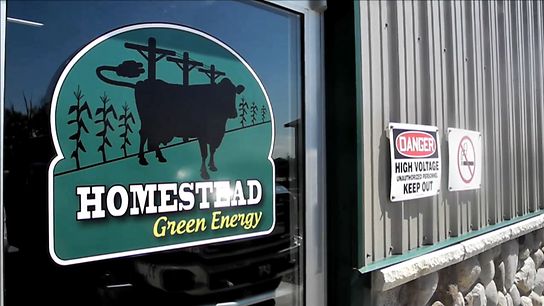Turning cow poo into power is profitable for US farm
Published on Sunday, 9 August, 2015 at 13:28

(AFP) For most farms, manure is a pungent problem. At Homestead Dairy, it smells like money.
The family-run American farm invested in a biogas recovery system which transforms cow poo and other waste into electricity.
Enough electricity, in fact, to power 1,000 homes, a service which the local utility company pays for handsomely.
But that's just a side benefit.
"It works economically, but one of the main reasons we did it was to try to help take care of the odor control for the neighbors," said Floyd Houin, whose family has owned the farm in Plymouth, Indiana since 1945.
"The land's important to us also because we produce a crop for feeding cows. So we want to do everything we can to take care of the land and the water. We drink the same water as everyone else."
Livestock farms typically store their effluent in open lagoons and the stench does not make them very popular with the neighbors.
The lagoons also have a significant environmental impact because they emit methane and carbon dioxide -- major contributors to climate change -- and can sully the groundwater if they leak or overflow during heavy rains.
Setting up an anaerobic digester, essentially a giant shed that uses heat to speed up decomposition, captures both the smell and the greenhouse gases.
Power one million homes
The Environmental Protection Agency estimates that more than three million tons of greenhouse gas emissions were eliminated last year by Homestead and the 246 other US livestock farms which have installed biogas recovery systems.
That's equivalent to taking more than 630,000 cars off the road.
There are about 8,000 dairy and hog farms in the United States which are large enough to make a biogas recovery system viable.
The EPA estimates they could generate enough electricity to power over a million homes and cut emissions by the equivalent of taking nearly four million cars off the road.
Biogas recovery is also being used to capture methane from landfills and sewage treatment plants and even at craft beer companies.
http://bcove.me/o8tla9a3
More videos can be found on our video page
"The federal government is really committed to seeing progress in this sector," said Allison Costa, program manager for the EPA's AgStar unit.
"Widespread investment and adoption could help us make significant inroads in helping us address some of our environmental and energy challenges."
The problem is the financing, Costa said. There's a huge upfront cost and most utility companies in the United States won't pay enough for the electricity to make the project appealing to a bank loan officer.
It also requires a lot of maintenance, which many farms don't have the manpower to manage. But when it works, Costa said, it really works.
"We've seen a lot of farms expand and build a second one," she stated.
"You just have to have someone willing to love that digester and take care of it."
Ryan Rogers, 31, loves his digester.
"There's so many (good) things, you forget them all," said Rogers, who married into the Homestead family and spends about four hours a day on digester maintenance and management.
Controlling the smell from the 70,000 gallons of manure and urine produced every day by the dairy's 3,400 cows clearly tops the list.
Then of course, there's the crops. The digester does a much better job of turning the manure into fertilizer, which means a better yield from the farm's 4,500 acres of corn.
Once that nutrient-rich liquid fertilizer is extracted, what's left makes for some nice soft bedding for the cows.
And instead of spending money to manage the manure, soon they'll be making money off it.
Recover cost in five years
The family managed to get a grant to help cover some of the cost of the facility and a favorable contact with the local power company which was looking to expand its renewable energy supplies.
They bring in extra income -- and fuel for the generators -- by charging restaurants and food processing plants a lower rate to dump their waste than the local landfill.
It will probably only take about five years until the initial investment is fully paid off, Rogers said. And it's working so well they're planning to build a second facility.
"It's definitely a growing field within the United States," said Mike Fenton of Michigan CAT, which sold the Caterpillar generators used by Homestead and helps them to maintain the system.
The European market is much more advanced because there are so many more subsidies available and the cost of electricity is so much higher, he said.
While US farmers may balk at the initial cost -- a system like the one at Homestead would run around $6 million -- Fenton said it's a good investment. Most farms can pay it off and start making a profit within three to five years.
"It's a proven technology that works really well," he explained.

Buildings housing generators and an anaerobic digester are seen at Homestead Dairy in Plymouth, Indiana on July 13, 2015. The family-run farm invested in a biogas recovery system which transforms cow manure and other waste into enough electricity to power 1,000 homes. Photo - AFP
IndianaDG Editor's Note: Homestead Dairy is participating in NIPSCO's voluntary feed-in tariff (VFIT) 1.0.


